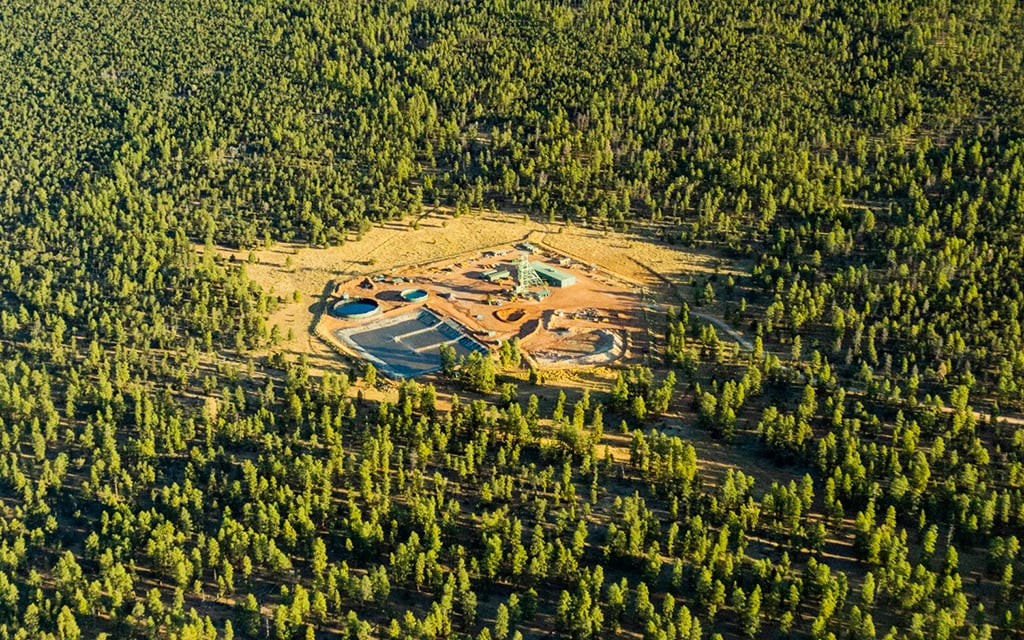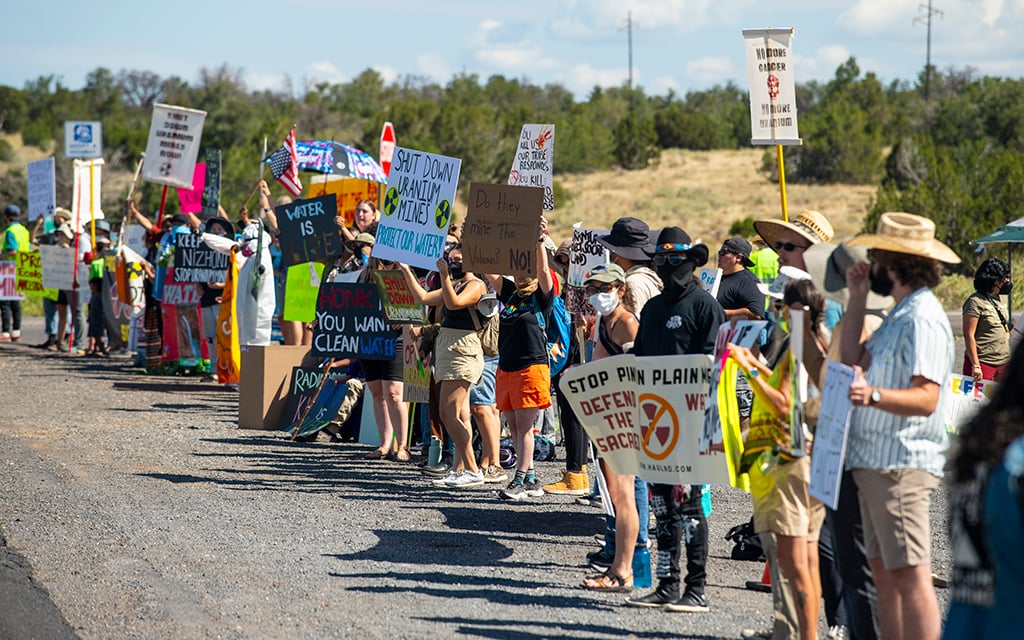PHOENIX — Although the Navajo Nation has reached an agreement with Energy Fuels Inc. on uranium transportation through tribal land, many tribal members remain concerned it won’t protect them from the harms of uranium contamination.
Tribal leaders say they had little choice but to enter the agreement, as federal law preempts any tribal regulations that conflict with it regarding the transportation of radioactive materials.
In between the four sacred mountains of the Navajo Nation, two large white trucks made a passage through the land coming from the Pinyon Plain Mine in Arizona’s Kaibab National Forest which sits just outside the western boundary of the Navajo Nation, to the White Mesa Mill in southern Utah.
The vehicles traveled more than 260 miles along Highways 89, 160 and 191 carrying a chemical all too familiar to the Navajo people, and the one that haunted them for years: uranium.
On July 30, 2024, Energy Fuels Inc., a publicly traded company specializing in uranium mining and milling, among other things, sent the trucks with “a very, very short notification time” before the transport, said Stephen Etsitty, executive director of the Navajo Nation Environmental Protection Agency, during a Navajo Nation Council meeting six months later.
This led to months of negotiations and the eventual development of a transportation agreement between Energy Fuels and the Navajo Nation, to set safety requirements and ensure accountability.
Title 49 in the Code of Federal Regulations outlines transportation requirements and classifies uranium ore as a Low Specific Activity material, “which is the lowest level of radioactive material hauled on roads and highways,” said Kris Beecher, acting deputy attorney general for the Navajo Department of Justice, at the meeting.
This means that moving uranium from one place to another is exempt from rigorous transportation requirements.
Indigenous communities in the Southwest have taken steps to prohibit uranium mining and transportation on their lands due to the history of contamination, illness and death.
In 2005, the Navajo Nation enacted the Diné Natural Resources Protection Act, which bans uranium mining and processing within its territory.
In 2012, the nation passed the Radioactive and Related Substances Equipment, Vehicles, Persons, and Materials Transportation Act, which prohibits the transportation of uranium on tribal lands.
However, federal law, specifically the Atomic Energy Act and the Hazardous Materials Transportation Act, regulates hauling of radioactive materials and overrides state and tribal regulations that go against them, also known as federal preemption.
“The Navajo Nation has done the next best thing by entering into an agreement with Energy Fuels,” Beecher said.

Map of the Energy Fuels Inc. uranium truck route highlighting the Indigenous nations it passes through from its start at the Pinyon Plain Mine in Arizona and its end at the White Mesa Mill in Utah. (Map courtesy of HaulNo!)
According to the agreement, at no cost to the Navajo Nation, the corporation has agreed to clean up 10,000 tons of uranium-bearing materials from abandoned mines scattered throughout Navajo land.
The company will also pay 50 cents per pound of processed uranium produced at the White Mesa Mill, which will amount to approximately $40,000 to $50,000 a month, “depending on the richness of the uranium ore, with that rate to be adjusted annually for inflation,” Beecher said during the meeting.
“There will be approximately 10 trucks per day and the transport can take two to four years, depending on the amount of ore obtained from the (Pinyon Plain) Mine,” Beecher said.
Energy Fuels also agreed to pay $1.2 million into the Navajo Nation CERCLA. “That funds uranium transport program and any remaining funds may be used more generally to support education, the environment, public health and welfare, transportation safety and local economic development,” Beecher said.
The company has plans to also mine uranium ore at the Roca Honda Mine near Mount Taylor in New Mexico.
If mining begins at Roca Honda, the existing agreement will apply to the transportation of uranium ore from that mine through Navajo land.
The Navajo Department of Justice and Environmental Protection Agency limited trucks to specific routes and hours of the day, prohibiting hauling during holidays and public events in respect of the culture and traditions of the nation.
Energy Fuels promised to give a 14-day warning in advance of its monthly schedule before entering the Navajo land.
“The Navajo Nation has suffered longstanding impacts from uranium mining conducted during the Cold War era,” said Mark Chalmers, president and CEO of Energy Fuels, in a press release earlier this year. “This has understandably caused mistrust toward the U.S. government and energy companies.”
Not all Navajo Nation officials were in favor of the terms of agreement, questioning their execution.
“We will be continued to be lied to … We won’t get the full packet,” said Vince James, a Navajo Nation council delegate, during the council meeting.
Other tribal members echoed that sentiment. Robyn Jackson, executive director of Diné C.A.R.E., a nonprofit organization advocating for environmental protection, voiced her concerns over Energy Fuels’ fulfillment of the agreement requirements, such as a dust cover as a preventative measure to ensure the radioactive debris does not escape the truck during transport.
“These trucks are only covered by a tarp and material particles could get out,” Jackson said. “And since this is primarily going through Navajo Nation, that’s Navajo communities that are being exposed to the uranium ore and radiation.”
Jackson said each vehicle is required to have a symbol indicating that it contains radioactive material, but the symbol is too small for community members to see.
Today, 85% of all Navajo people live in uranium-contaminated homes, according to an investigation from the Pulitzer Center.
The effects of uranium vary, from shortness of breath and irritation to the skin after exposure to cancer and aggressive forms of autoimmune disease.
The stakes are higher for those on the Navajo land due to zinc deficiency, said Jonnye Lewis, director and founder of the Community Environmental Health Program (CEHP), which is dedicated to studying the environmental effects of uranium and mine waste exposure on tribal land.

The levels of radioactive materials showcasing the amount of radiation in uranium, according to Energy Fuels Inc. (Image courtesy of Energy Fuels).
“What we see, especially on Navajo, is that you have some basic fundamental deficits in nutrition, and those also contribute to the toxicity of the metals,” said Lewis.
For almost 40 years, Navajo men, women and children worked in uranium mines, where radioactive contamination spread to livestock and farmland. Children often played in open pit mines, unaware of the health risks posed by radioactive waste.
Leona Morgan did not grow up in a contaminated environment, but her family has seen the effects of uranium. She co-founded Haul No!, a nonprofit organization that informs communities about nuclear mining and milling.
“People are scared, there are health problems, and the rez (reservation) doesn’t have a cancer center,” Morgan said. “When people have kidney problems, they have to go to dialysis. They oftentimes drive four hours from the rez to somewhere and pick up people along the way, it’s an all-day thing.”
In the past, people affected by uranium could receive financial relief outlined in the Radiation Exposure Compensation Act. The law failed to pass reauthorization and is no longer providing any compensation.
Energy Fuels has not disclosed specific revenue figures solely from its Pinyon Plain Mine operations. However, in 2024, the company reported total uranium sales of 450,000 pounds, generating a gross profit of $21.32 million with a 56% gross margin, which means the company kept 56 cents per dollar as gross profit after covering the direct costs of production, such as mining, milling and transportation.
The average realized prices were $75.13 per pound when selling uranium under long-term agreements with buyers, and $91.51 per pound while selling uranium on the open market without long-term arrangements.
President Donald Trump issued the Immediate Measures to Increase American Mineral Production executive order on March 10, which encourages public and private partnerships and capital investment in domestic mineral production.
“We are trying to fend off these renewed mining activities, but it is coming and we just have to continue to fight,” Etsitty, with the Navajo EPA, said.



